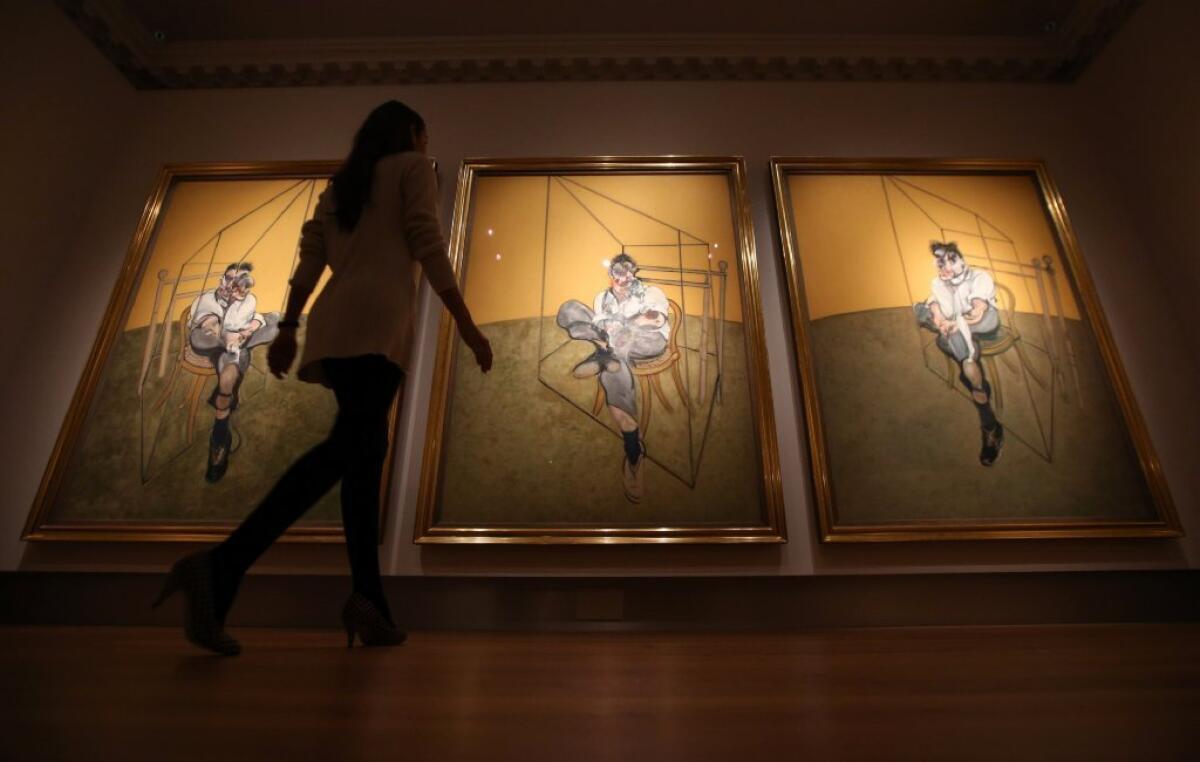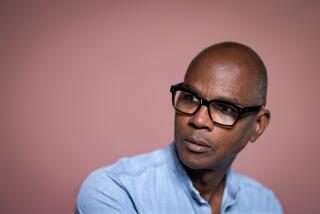Report: Super-rich, favoring just a few artists, drive art market

Culture Monster has seen a picture of the global art market, and it looks very much like a portobello mushroom.
The glimpse came not in a photograph, painting or drawing, but from the 83-page annual “TEFAF Art Market Report” issued recently by the European Fine Art Foundation.
It found that the art business rests on a very slender stem of prized artists whose work has sprouted a vast canopy of cash, paid overwhelmingly by a coterie of 600,000 or so global millionaires who qualify as “mid- to high-level art collectors.”
The report found that 8% of the art auctioned worldwide in 2013 accounted for 82% of the money spent. In the United States, the ratio was even more skewed: 7.5% of the works auctioned raked in 91.2% of the bucks.
PHOTOS: The most fascinating arts stories of 2013
While auction sales accounted for only 47% of the $63 billion or so spent on art worldwide, the report’s author, arts economist Clare McAndrew, wrote that the same phenomenon applies across the board: “a small number of [artists] accounting for an increasingly large share of total sales….is also true of the dealer market, with high-end dealers commenting that their top collectors appeared to be interested in the work of only about 50 to 100 artists.”
McAndrew ‘s report states most aggregate art sales in euros; applying average exchange rates for each year to convert them to dollars, the $63-billion sales estimate for 2013 fell a bit short of the global art market’s pre-recession peak of $65.8 billion in 2007.
The report by the Netherlands-based European Fine Art Foundation derived its estimates by crunching numbers from two major clearinghouses for art auction information (one for China, one for the rest of the world), and weaving in responses from a survey of about 5,500 art dealers who had annual sales exceeding 2 million euros (about $2.7 million).
When we’re talking about the people who really, really matter in the art market, the report informs us, we’re talking not about those 600,000 mere millionaires and their tastes, but about just under 200,000 “ultra-high net worth individuals” (UHNWIs) who sit atop piles of $30 million or more.
These folks – a third of them Americans, by far the largest national share -- command $28 trillion in wealth, we’re informed, and their art holdings account for about 1.7% of their net worth. That’s about $476 billion worth of art.
CRITICS’ PICKS: What to watch, where to go, what to eat
We’re told that these UHNWIs devote about 10% of their money to “investments of passion” such as art, jewelry, other collectibles and sports -- and that globally art accounts for 17 cents out of every dollar devoted to “investments of passion.”
North American rich folks are deemed the most passionate about art, devoting 19 cents out of every dollar in “passion” investments to it, compared to a nickel for sports and 31 cents for their favorite category, “other collectibles” -- a grab-bag that includes antiques, rare coins, vintage wines and such.
The report says that Japanese uber-wealthy are the least art-inclined, with just a 12-cent allocation of their passionate investment buck. High rollers from all continents apparently share a fondness for bling, devoting 30 to 35 cents of their passionate investment dollar to jewelry and gems.
The report’s most encouraging news for auctioneers and dealers patronized by the ultra-rich, and for the elect few living artists the top collectors focus on, is that “many HNWIs are increasingly approaching luxury goods as investments, and looking for those sectors that have the most long-term value, notably art and antiques.”
Such a mindset may have been at play in 2013 when Francis Bacon’s three-part painting, “Three Sides of Lucian Freud,” established a new auction record for a single work, $142 million.
PHOTOS: Faces to watch 2014 | Art
Or maybe the anonymous buyer just loved it that much (the New York Times has reported that art world speculation pointed toward Elaine Wynn, who serves on the board of the Los Angeles County Museum of Art).
It may be worth remembering that for a billionaire, such a purchase is the proportional equivalent of a person whose net worth is $100,000 springing for a $14,200 used car -- not exactly pocket change, but not something the neighbors would think incredibly extravagant (the median net worth of American families was $77,300 in 2010, according to the Federal Reserve -- meaning half were at least that wealthy, while the other half made do with less).
An estimated 38% of the money spent on art in 2013 was spent in the United States, according to the report, although U.S. sales accounted for only 21% of the works sold. China, which in 2011 had briefly edged past the U.S. in total expenditures for art, has fallen back into second place at 24% of global spending, although Chinese dealers and auctioneers handled nearly double the U.S. volume -- 41% of the artworks moved worldwide. Note that national totals reflect art sold in a country, not art bought by its citizens. Some would be purchased by foreigners who were visiting, or who placed auction bids by phone.
All this activity supports a global art-sales industry encompassing some 308,525 businesses with 2.5 million employees, the report says; the U.S. ranks first with 587,000 art market jobs.
Of works sold at auction, post-World War II and contemporary art fetched nearly half the money forked over globally (46%), followed by modern art (29% - and defined as works by artists born from 1875 to 1910), 13% for Impressionists and post-Impressionists and 10% for Old Masters (artists born before 1821). All other categories accounted for 2% of sales.
PHOTOS: Faces to watch 2014 | Art
Of the 80 works auctioned for more than 10 million euros (about $13.3 million) during 2013, the report said that most were postwar and contemporary works, defined as ones by artists born after 1910. Some 36,000 individual postwar/contemporary artists produced those pieces, the report said, but a slim minority accounted for the vast majority of the money spent.
This isn’t to say that the American middle class is completely out of the game when it comes to the art market. According to the report, half of the postwar and contemporary art auctioned in the United States in 2013 sold for $3,867 or less – cheaper than the global median price of about $5,100.
Still, there’s no denying the mushroom effect. Because most of the money gets spent at the high end, the average auction price for post-World War II art in the United States was $95,214 -- nearly 25 times higher than the median price.
So has art turned into that mushroom? Yes, if you only look at the numbers. But not, luckily, if you can manage to ignore them and concentrate on what’s hanging on the wall.
ALSO:Art prices reflect income inequality
Arts and culture was fastest-growing philanthropic cause in 2012
Francis Bacon triptych to go on view in Oregon; buyer remains unknown
More to Read
The biggest entertainment stories
Get our big stories about Hollywood, film, television, music, arts, culture and more right in your inbox as soon as they publish.
You may occasionally receive promotional content from the Los Angeles Times.











